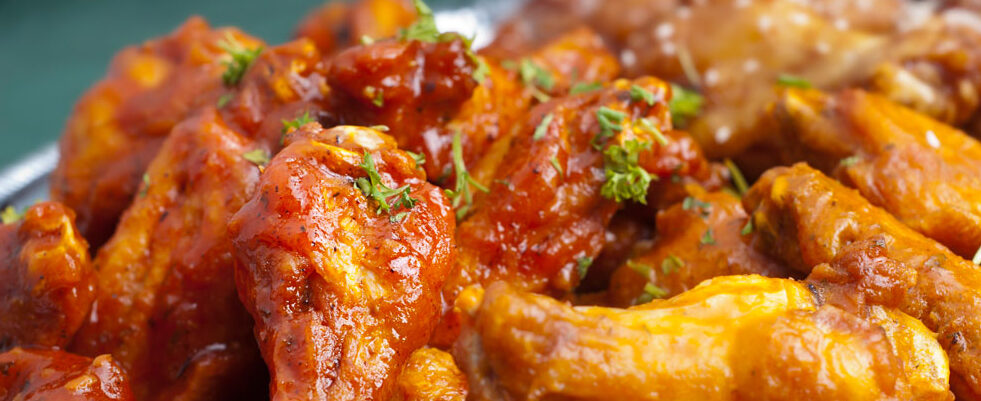Message from the USDA regarding food safety at your party.1
WASHINGTON, 29 de enero de 2024 — Servir de manera segura a amigos y familiares durante el gran partido es una victoria para todos; no lo malogres este Super Bowl Sunday. El 11 de febrero marca el inicio del Super Bowl LVIII, y los aficionados al fútbol se agruparán para ver el gran juego mientras disfrutan de sus comidas favoritas. Ya sea que estés ordenando a domicilio o preparando y sirviendo comida a los invitados, el Servicio de Inspección y Seguridad Alimentaria del Departamento de Agricultura de los Estados Unidos (FSIS por sus siglas en inglés) tiene algunos planes para el día del juego para evitar que tu Super Bowl sea interceptado por enfermedades transmitidas por los alimentos.
“Las fiestas del Super Bowl son un momento divertido para que la gente se relaje y disfrute del gran juego, pero la seguridad alimentaria debe seguir siendo una prioridad principal”, dijo el Subsecretario de Agricultura de los Estados Unidos para la Seguridad Alimentaria, el Dr. Emilio Esteban. “Pasos simples como no dejar la comida a temperatura ambiente por más de dos horas o mantener las comidas calientes y las comidas frías pueden ayudar a mantener a salvo a tus amigos y familiares”.
Sigue estos consejos del USDA para evitar quedarte fuera de juego con la seguridad alimentaria este Super Bowl Sunday.
Entregas y Comidas para Llevar
Si estás ordenando comida para llevar temprano en el día antes del gran juego, asegúrate de que alguien esté allí para recibir la comida de manera oportuna. Coloca cualquier comida que no se vaya a comer de inmediato en el refrigerador. Al almacenar sobras, divídelas en porciones más pequeñas y colócalas en recipientes pequeños y poco profundos. Las comidas perecederas que hayan estado fuera a temperatura ambiente deben ser consumidas dentro de las dos horas después de cocinarse.
Mantente en la Zona de Juego, no en la Zona de Peligro
Si estás sirviendo comida a grupos, sigue la regla de las dos horas. Cuando las comidas perecederas permanecen en la Zona de Peligro (temperaturas entre 40 F y 140 F) durante más de dos horas, las bacterias pueden multiplicarse rápidamente. La carne y las aves deben refrigerarse o congelarse dentro de las dos horas después de estar fuera en una encimera en la Zona de Peligro. Si quieres disfrutar del gran juego y servir comida por más de dos horas, mantén las comidas calientes a una temperatura de 140 F o más utilizando bandejas de calentamiento, platos chafing o una olla de cocción lenta. Las comidas frías deben mantenerse a 40 F o menos. Para mantenerlas frías, sírvelas en porciones más pequeñas y rellénalas, o coloca la comida en recipientes y colócala en hielo.
No Dejes que las Sobras se Queden en la Banca
Tus sobras del Super Bowl estarán seguras durante tres a cuatro días en el refrigerador. Reecha las sobras a la temperatura interna segura de 165 F, medida con un termómetro de alimentos. Recalienta alimentos líquidos como sopas y salsas hasta que hiervan. Probar la comida para determinar su seguridad es peligroso. Cuando haya dudas, ¡desecha!
Recuerda Siempre los Cuatro Pasos para la Seguridad Alimentaria
- Limpieza: Lava tus manos durante al menos 20 segundos antes, durante y después de la preparación de la comida. Limpia y desinfecta las superficies con frecuencia con agua, jabón y un desinfectante. En un estudio reciente del USDA, el 96% de los intentos de lavado de manos fallaron debido a la omisión de todos los pasos necesarios.
- Separación: Usa tablas de cortar separadas: una para carne cruda y aves y otra para frutas y verduras. Mantén los alimentos crudos separados de los alimentos listos para comer y de los utensilios.
- Cocción: Cocina la carne y los productos avícolas a una temperatura interna segura utilizando un termómetro de alimentos.
- Refrigeración: Coloca los alimentos que ya no se están comiendo de nuevo en el refrigerador o congelador dentro de las dos horas de haber estado fuera a temperatura ambiente.
Si tienes preguntas sobre seguridad alimentaria, llama a la Línea Directa de Carnes y Aves del USDA al 1-888-MPHotline (1-888-674-6854), envía un correo electrónico a MPHotline@usda.gov o chatea en vivo en www.ask.usda.gov de 10 a.m. a 6 p.m. hora del este, de lunes a viernes.
Accede a comunicados de prensa y otra información en el sitio web del Servicio de Inspección y Seguridad Alimentaria del USDA (FSIS) en www.fsis.usda.gov/newsroom. Sigue a FSIS en X en @usdafoodsafety o en español en X @usdafoodsafety_es.
El USDA toca las vidas de todos los estadounidenses cada día de muchas maneras positivas. En la Administración Biden-Harris, el USDA está transformando el sistema alimentario de Estados Unidos con un mayor enfoque en una producción local y regional de alimentos más resiliente, mercados más justos para todos los productores, asegurando el acceso a alimentos seguros, saludables y nutritivos en todas las comunidades, construyendo nuevos mercados y fuentes de ingresos para agricultores y productores mediante prácticas alimentarias y forestales inteligentes para el clima, realizando inversiones históricas en infraestructura y capacidades de energía limpia en la América rural, y comprometiéndose con la equidad en todo el Departamento al eliminar barreras sistémicas y construir una fuerza laboral más representativa de Estados Unidos. Para obtener más información, visita www.usda.gov.
Don’t Let Delivery and Takeout Foods Fumble Your Super Bowl
WASHINGTON, Jan. 29, 2024 — Safely serving friends and family during the big game is a win for everyone; don’t fumble it this Super Bowl Sunday. February 11 kicks off Super Bowl LVIII, and football fans will be huddling up to watch the big game while enjoying their favorite foods. Whether you’re ordering delivery, or preparing and serving food to guests, the U.S. Department of Agriculture’s (USDA) Food Safety and Inspection Service (FSIS) has some gameday plans to keep your Super Bowl from being intercepted by foodborne illness.
“Super Bowl parties are a fun time for people to unwind and enjoy the big game, but food safety must remain a top priority,” said USDA Under Secretary for Food Safety Dr. Emilio Esteban. “Simple steps like not leaving food out at room temperature for more than two hours or keeping hot foods hot and cold foods cold can help keep your friends and family safe.”
Follow these USDA tips to avoid getting caught offside with food safety this Super Bowl Sunday.
Deliveries and Takeout Foods
If you’re ordering takeout earlier in the day before the big game, make sure someone is there to get the food in a timely manner. Place any food that is not being eaten immediately in the refrigerator. When storing leftovers, divide them into smaller portions and place them into small, shallow containers. Perishable foods that have been sitting out at room temperature must be eaten within two hours after being cooked.
Stay in the In Zone, not the Danger Zone
If you’re serving food to groups, follow the two-hour rule. When perishable foods sit in the Danger Zone (temperatures between 40 F and 140 F) for more than two hours, bacteria can multiply rapidly. Meat and poultry must be refrigerated or frozen within two hours of sitting out on a counter in the Danger Zone. If you want to enjoy the big game and serve food longer than two hours, keep hot foods hot and cold foods cold. Hot foods must be kept at 140 F or above by using warming trays, chafing dishes, or a slow cooker. Cold foods must be kept at 40 F or below. To keep them cold, serve them in smaller portions and refill them, or place the food in containers and nestle them in ice.
Don’t Let Leftovers Sit on the Sidelines
Your Super Bowl leftovers will be safe for three to four days in the refrigerator. Reheat leftovers to the safe internal temperature of 165 F as measured with a food thermometer. Reheat liquid foods like soups and sauces to a boil. Tasting food to determine its safety is dangerous. When in doubt, throw it out!
Always Remember the Four Steps to Food Safety
- Clean—Wash your hands for at least 20 seconds before, during, and after meal preparation. Clean and sanitize surfaces often with soap, water and a sanitizer. In a recent USDA study, 96% of handwashing attempts failed due to missing all the necessary steps.
- Separate—Use separate cutting boards: one for raw meat and poultry and another for fruits and vegetables. Keep raw foods separate from ready-to-eat foods and utensils.
- Cook—Cook meat and poultry products to a safe internal temperature by using a food thermometer.
- Chill—Place foods that are no longer being eaten back into the refrigerator or freezer within two hours of sitting out at room temperature.
If you have food safety questions, call the USDA Meat and Poultry Hotline at 1-888-MPHotline (1-888-674-6854), email MPHotline@usda.gov or chat live at www.ask.usda.gov 10 a.m. to 6 p.m. Eastern Time, Monday through Friday.
Access news releases and other information at USDA’s Food Safety and Inspection Service’s (FSIS) website at www.fsis.usda.gov/newsroom. Follow FSIS on X at @usdafoodsafety or in Spanish at X @usdafoodsafety_es.
USDA touches the lives of all Americans each day in so many positive ways. In the Biden-Harris Administration, USDA is transforming America’s food system with a greater focus on more resilient local and regional food production, fairer markets for all producers, ensuring access to safe, healthy and nutritious food in all communities, building new markets and streams of income for farmers and producers using climate smart food and forestry practices, making historic investments in infrastructure and clean energy capabilities in rural America, and committing to equity across the Department by removing systemic barriers and building a workforce more representative of America. To learn more, visit www.usda.gov
- Translation to Spanish courtesy of Chat GPT. ↩︎






